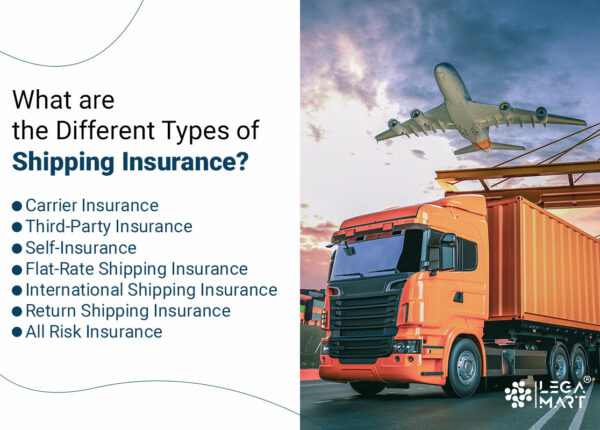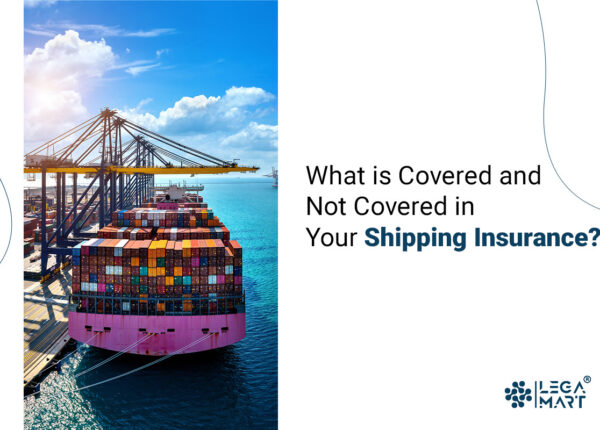- What is Shipping Insurance?
- What are the Different Types of Shipping Insurance?
- What are the Features of Shipping Insurance?
- Who is Responsible for Shipping Insurance?
- How Does Shipping Insurance Work?
- How Much Does Shipping Insurance Typically Cost?
- Does Shipping Insurance Include the Cost of Shipping?
- Actors involved in the Shipping Insurance market
- Who Does Shipping Insurance Protect and Cover?
- What are the Benefits of Shipping Insurance?
- Conclusion
Introduction
After losing her job due to the pandemic, like many others, Alice decided to set up an eCommerce store, a venture currently trending with everyone purchasing goods and services online. 85% of her orders sustained damage during transit. She skipped shipping insurance and eventually lost all her savings on reimbursing angry customers, losing her business’ reputation in the market.
You can avoid making the same mistakes as Alice by reading this article on “Different types of shipping insurance.” Selling products online is about setting up a medium, a payment portal, and delivering goods to customers. Here delivering is the last and most integral part, more emphasis has to be given to it. Nobody likes to pay for broken goods. What can someone do in this situation? Lose goodwill or focus on the shipping part?
In such a situation, the weapon to rescue is shipping insurance. This article aims to explain the concept of shipping insurance in a simplistic way.
What Factors Determine the Choice of Law in Shipping Contracts? – Legamart
What is Shipping Insurance?
In simplest terms, shipping insurance, also known as marine insurance, is the protective measure for securing products for shipment. Shipping insurance can safeguard goods from tragic events that may include larceny, deterioration, inappropriate handling, etc. The insurer will bear the financial burden for such goods until they reach the specified shipping site.
It is not an easy task as shipping involves multiple stages and processes that have to take place, and there it is essential to have a safety net for an event where even one thing out of all the procedures might go wrong. If goods get damaged, the seller will have to forgo revenue and focus on refunding the amount or sending another set. To sum it up, shipping insurance is a form of assistance that will protect the seller from parcels that may be stolen, vandalized, or misplaced.
What are the Different Types of Shipping Insurance?

Among the different types of shipping insurance available on the market, the choice of insurance depends on the situation and needs of the individual. Each shipping insurance has its advantages and disadvantages.
Carrier Insurance
The most preferred out of different shipping insurances. It is usually furnished by the shipping corporation. In this type of shipping insurance, an insurance provider or company is behind the coverage of the policy, having the financial resources to back it up. It is the policy issuer and the one who charges the premium and pays for losses and claims covered under the policy.
Here the insurance company pledges to pay the insured for the financial losses covered under the applicable claims scenarios and charges a hefty premium for this service. But it is crucial to view the terms and conditions of the policy beforehand.
Third-Party Insurance
With the advent of shipping insurance providers, this type of insurance is becoming popular. Here, a third-party insurer bears full accountability for the package and will cover the expenditures for refunds or replacements.
With a third-party insurer, you can be assured that the processing time for claims will be much lesser. Regardless, out-of-the-pocket costs could quickly add up, making it more expensive.
Self-Insurance
Finally, the last option is self-insurance. The most cost-effective insurance protects packages shipped through carriers and delivers more comprehensive security at lesser prices.
Flat-Rate Shipping Insurance
In this type of insurance, the customer pays a fixed price for shipping, irrespective of the size or weight of the package. This means that the insurance rates are somewhat dependent on the value of the shipped goods. This is a cost-effective insurance for a high volume of goods.
International Shipping Insurance
As the name suggests, this type of insurance is used for international orders, which are more likely to be misplaced or damaged. Therefore, this insurance is ideal for someone who is engaged in a lot of overseas business. However, this mainly works for high-value shipments, which means it is more expensive than other types of insurance.
Return Shipping Insurance
This type of insurance is used to protect both the buyer and the seller from shipping costs in the event that an unsatisfactory product has been returned. This insurance is proven to improve customer satisfaction levels.
All Risk Insurance
As the name suggests, this is the most comprehensive coverage available to e-commerce retailers. This insurance protects goods against all risks arising during the supply chain. However, this type of insurance is more expensive than others since it covers domestic and international shipments and provides end-to-end coverage.
Other Factors Influencing Types of Insurance
Apart from the types of insurance mentioned above, there are various types of policies under these insurances, which are dependent on a range of factors:
- Time Policy – The insurance coverage is for a specific period, for instance, one year.
- Voyage Policy – The insurance coverage is available for a specific voyage. This means that the insurance also expires as soon as the voyage or the trip ends.
- Mixed Policy – This type of policy combines the time policy and voyage policy. Therefore, the policy covers voyages taken between specific destinations during a specific period.
- Valued Policy – This means that the transportation for the value of the cargo is mentioned beforehand, which is then used to determine the coverage level of the plan. Therefore, if cargo is lost, the value mentioned in the policy is used to pay the claim.
- Unvalued Policy – This is when the value has not been determined beforehand. Therefore, the actual loss suffered is used to determine the estimate of the claim.
What are the Features of Shipping Insurance?
With increased online sales comes an increase in shipping insurance options for e-commerce businesses and online merchants to use to their advantage. The circumstances covered by these insurances will differ widely depending on the insurance policy chosen and the shipping company that is providing the services.
Generally, these insurances protect occurrences in which the seller has no power, such as uncertainty or delay in delivery, harm to cargo, etc. Each provider has distinctive requirements, conditions, limitations on goods, and other unusual coverage details that sellers need to evaluate before selecting an insurance provider for their goods.
Who is Responsible for Shipping Insurance?

When the question arises about who is responsible for shipping insurance, various factors come into play. Nevertheless, the answer depends on the fine print, i.e., Terms and Conditions.
An event without coverage could result in the claim being denied, or insurance may be restricted when high-value items are covered. There may also be restrictions on particular destinations. There are different terms for National (Low-risk) and International orders (High-Risk).
How Does Shipping Insurance Work?
So, what if your goods were damaged or misplaced?
Not to worry!
Simply file a claim to receive compensation for its monetary losses.
Claims can be made by various means, both online and offline. It purely depends on the carrier under a specified time frame. If the time limit has lapsed, the claim is unlikely to be heard.
For proof, documentation can be supplied, such as a certificate of insurance, shipping tag, photographs of any damage, or any other proof to help speed up the process. But in the end, the time to process the claims will rely on the insurance provider, resulting in one of three outcomes: a claim fully approved, partially approved, or denied.
If insurance claims are approved, funds are refunded promptly. Nevertheless, if a claim is denied, the reasons for denial will be shared, and an appeal can be filed. Every insurance carrier will have its regulations for claim processes.
How Much Does Shipping Insurance Typically Cost?
Various shipping companies offer insurance, so it’s challenging to create a specific insurance rate. The cost can vary per company depending on the package sent and the frequency of shipments. If deciding to approach any carrier or third-party insurance provider, anyone can expect the average cost to be 1.5% to 4% of the object’s value to be delivered.
Does Shipping Insurance Include the Cost of Shipping?
A lot of consumers do not believe in the concept of shipping insurance. As a measure, insurance can be included in the delivery amount or counted as a value-added service. It is very convenient nowadays to add shipping insurance to the package.
Actors Involved in the Shipping Insurance Market

Various actors are involved in the shipping insurance market, each with its unique role and responsibility. The most common actors involved in the process are:
- Agents of Insurance. Brokers providing this insurance work as middlemen between the customers and the company. They help customers compare insurance products and are often well-versed in the shipping insurance market. If involved with the company, they also help the company find a suitable policy.
- Carriers. Freight Forwarder company helps in the transfer of products from one stop to another. There are some freight forwarder companies that offer insurance to the customers, provided that they are paid extra for the same.
- Shippers. These are businesses that help transport items to customers or other companies. These become the primary purchasers of shipping insurance, and it is upon them to choose and purchase the best coverage according to their requirements.
Who Does Shipping Insurance Protect and Cover?
The insurance company provides protection to the seller for any losses that may be incurred on their goods during the transportation. What comes under the purview of shipping insurance purely depends on the value of goods and the carrier company. Therefore, the conditions that will be covered by shipping insurance will vary widely based on the shipping insurance policy selected and the shipping company that is supplying the services.
Generally, shipping insurance protects against incidents in which the seller has no control, such as delivery delays, damage to goods, or shipping malpractices that take place before delivery. More information can be found on the carriers’ websites for DHL, UPS, USPS, Maersk, HDFC Ergo, and one of the most popular ones, FedEx.
How to file a claim with UPS?
It is possible to file a claim with UPS online within 60 days from the date of scheduled delivery. It is possible for the sellers to make a claim in case a package has been damaged, lost, or if delivery payment has not been received. You first need to bring a claim with the package details and the tracking number previously provided to you. For this, you are expected to identify yourself as the seller, especially if the shipments are from your business. Try providing any additional documentation or information related to the package for ease of identification.
In case the claim is for damage, attach the requisite photo proof, which is further capable of strengthening your case. Once the application has been submitted, keep note of the same through the track mode. UPS consists of a customized claims dashboard, wherein it is possible for the applicant to edit the claim information, upload additional documentation, receive updates, review history, etc.
How to file a claim with FedEx?
It is possible to file a claim with FedEx within 60 days of shipment. You first need to complete the online form with the PRO number or the tracking number. You are expected to upload the required documentation and proofs and submit the application. During the entire claims process, ensure that you have your original packaging and the contents for the inspection procedure. In case your shipment has a declared value between $100 to $1000, it is possible to conduct a self-inspection and print the details. Otherwise, inspection shall be conducted by FedEx themselves. Finally, keep track of your application through the FedEx site until the issue has been resolved.
How to file a claim with USPS?
It is possible to file a claim with USPS, either online or through the mail. Interestingly, USPS has its filing period and even allows for an appeal if the claim is denied. The filing process contains 3 steps:
- Check filing periods. Each of USPS’s services has its separate filing period. They are mostly dependent on the mailing date listed on the shipping receipt. However, damage claims are an exception, considering that they must be filed within 60 days from the send date.
- Gather your documents. Ensure that all evidence and documentation have been stored. The claims should ideally consist of original mailing receipts, documentation proofs, evidence of damage, etc.
- File your claim. Usually, online claims are faster for USPS, and it also becomes easier to track the claims history.
In case the claim is approved by USPS, the requisite payment is processed by the company within 7-10 days. However, in case the claim is partially or fully denied, you have 30 days to file for an appeal. The method for submitting the appeal is the same as the original claim application. However, you must challenge the reasons based on which the original claims were denied and add any new supporting documentation evidence that might help further your case. You also have the option for a second appeal within 30 days from the rejection of the first appeal.
What is Covered and Not Covered in Your Shipping Insurance?

The following items are usually covered by your shipping insurance:
- Theft/Pilferage
- Total loss of any package while Loading/Unloading
- Malicious damage
- Collision of goods carrying vessels
- Fire, Lightening or Explosion
- Collision, Overturning or Derailment of Land Conveyance
- Breakage of Bridge
- Stranding, Grounding, or Sinking
- Earthquake or Volcanic Eruptions
- Water entering the vessel during transportation
- Protection against natural calamities
- Delivery of goods/cargo at different locations
- Contact of goods carrying vehicle with structure/animal
However, the following items are usually not covered by your shipping insurance:
- Unsuitable and Insufficient Packaging
- Unfit Container
- Willful Misconduct
- Mishandling of goods in transit
- War risk
- Bulk Cargo
- Temperature Sensitivity
- Ordinary wear and tear
- Delay
Please note that there might be insurance types that are capable of covering items that are not ordinarily covered. Therefore, read on to the insurance coverage document in a proper fashion before going ahead with it.
What are the Benefits of Shipping Insurance?
The benefits of shipping insurance include saving money, protecting goods, having peace of mind, obtaining insurance easier, having no additional fees, and, most significantly, covering losses!
Conclusion
If you are Alice and worried about a situation where your orders are lost, broken, or missing during transit to customers, then it is high time you consider getting this insurance. But always be careful, as insurers will have restrictions in places that may render the package uninsurable or force limitations on the limit to which protection will be granted. In this case, it is recommended to take legal help to find out about the right insurance package as well as checking upon the conditions and limitation the insurance will be applicable. Few carriers also have conditions on what can and cannot be shipped.
With the pandemic, there has arisen a huge level of uncertainty. It shows that multiple factors can go awry during shipping, so having insurance will be good for the pocket. The article aimed to simplify the complicated information on shipping insurance and shows that it brings a difference between breaking a business and building one up.
Frequently Asked Questions
What should be considered while choosing the appropriate shipping insurance policy?
While choosing an appropriate shipping insurance policy, you should consider the value of your goods, the reputation and reliability associated with your goods, the level of protection required, and the terms and conditions of the policy you are considering. Ensure that you read your policy carefully to understand the extent of protection offered to you.
Is it mandatory to have shipping insurance?
No, it is not mandatory to have shipping insurance. However, it is highly recommended to have one. This is especially useful if you are someone dealing with fragile goods.
How do you file a claim under your shipping insurance?
If you have experienced any problem with your shipping, which is adequately covered within your shipping insurance, then you must contact your insurance provider immediately or contact the carrier who has the responsibility of carrying your goods. Through them, you can receive further instructions on how to proceed with your claim.




